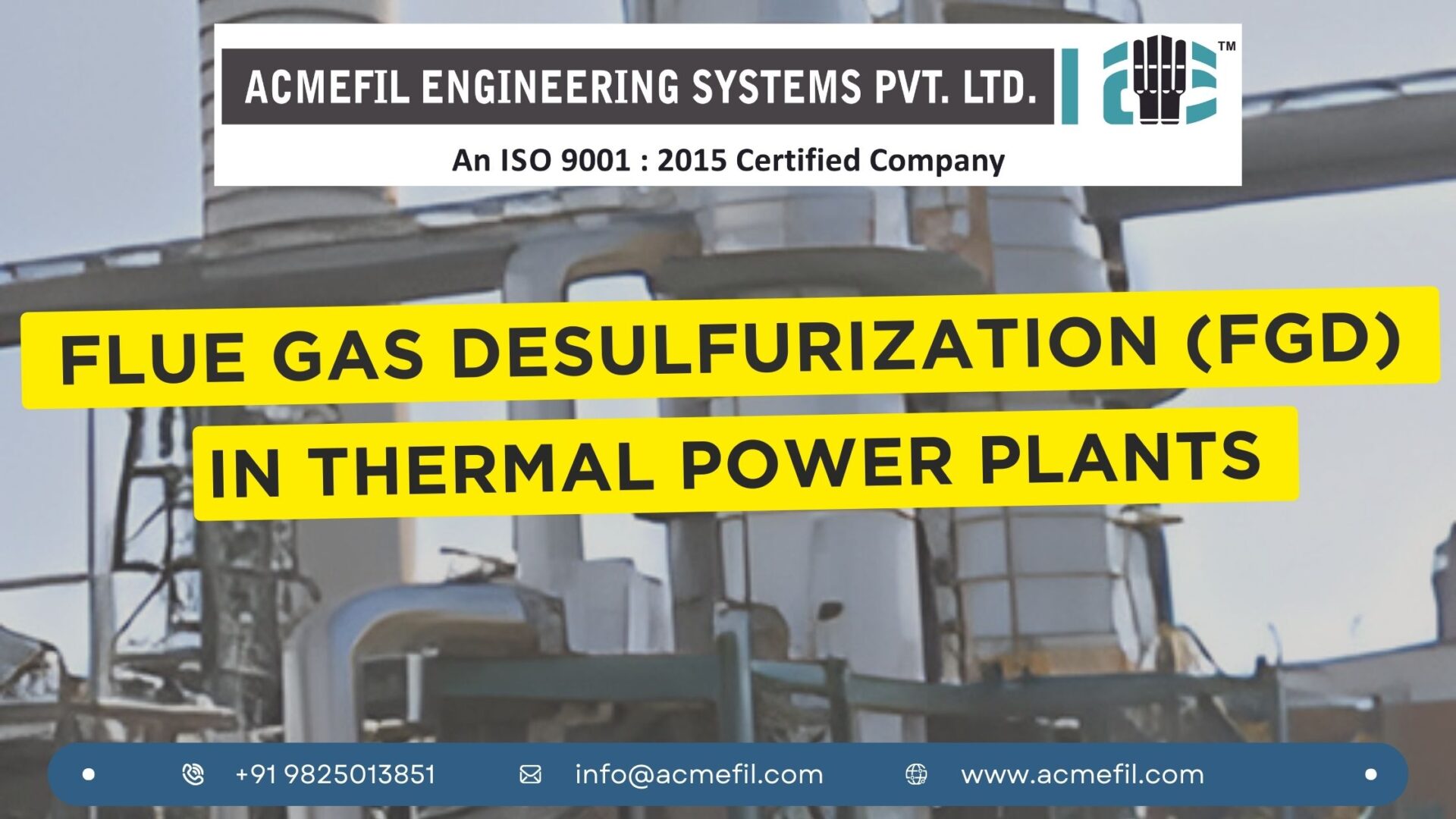Thermal power plants significantly contribute to electricity generation but also emit large amounts of sulfur dioxide (SO2), a major air pollutant. Flue gas desulfurization (FGD) systems effectively reduce SO2 emissions. At Acmefil Engineering Systems Pvt. Ltd., we design and implement advanced FGD systems for thermal power plants. This detailed guide explores flue gas desulfurization, its importance, and the various FGD systems used in thermal power plants.
About Acmefil Engineering Systems Pvt. Ltd.
Acmefil Engineering Systems Pvt. Ltd. leads in designing, manufacturing, and supplying advanced air pollution control systems. With decades of experience and a commitment to innovation, we provide cutting-edge solutions to clients in the power generation industry. Our dedication to quality and customer satisfaction has established us as a trusted name in environmental engineering.
Flue Gas Desulfurization (FGD) in Thermal Power Plants
Flue gas desulfurization removes sulfur dioxide (SO2) from the exhaust flue gases of fossil-fuel power plants. FGD systems aim to reduce air pollution and comply with environmental regulations.
Key Components and Functionality of FGD Systems
Absorber
The absorber serves as the core component of an FGD system in thermal power plants. Here, the removal of SO2 occurs. The flue gas passes through a scrubbing liquid, usually a mixture of limestone (calcium carbonate) and water. The SO2 reacts with the limestone slurry to form calcium sulfite, which then oxidizes to form gypsum (calcium sulfate).
- Efficient SO2 Removal: The absorber ensures that the flue gas comes into contact with the scrubbing liquid, maximizing SO2 removal.
- High Surface Area: Trays or packing materials increase the surface area for gas-liquid contact.
Reagent Preparation System
The reagent preparation system prepares the limestone slurry used in the absorber. It involves grinding limestone into a fine powder and mixing it with water to create the slurry.
- Grinding Mills: These reduce the limestone to the required particle size for effective SO2 absorption.
- Slurry Tanks: These store and mix the slurry, ensuring a consistent supply to the absorber.
Oxidation and Gypsum Production
In the oxidation step, the calcium sulfite formed in the absorber oxidizes to produce gypsum. This process typically takes place in a separate oxidation tank.
- Oxidation Tank: Air is blown into the tank to facilitate the oxidation reaction.
- Gypsum Dewatering: The gypsum produced is dewatered using centrifuges or vacuum filters to produce a solid product for use in the construction industry.
Wastewater Treatment
FGD systems produce wastewater that requires treatment before discharge. The wastewater treatment system removes contaminants such as heavy metals and suspended solids.
- Clarifiers: These remove suspended solids from the wastewater.
- Chemical Treatment: Adding chemicals precipitates heavy metals, which are then removed through filtration.
Types of FGD Systems for Thermal Power Plants
Wet FGD Systems
Wet FGD systems are the most common type used in thermal power plants. They use a liquid absorbent, typically a limestone slurry, to remove SO2 from the flue gas.
- High Efficiency: Wet FGD systems can achieve SO2 removal efficiencies of up to 95%.
- Versatility: They effectively handle a wide range of sulfur contents in the fuel.
Dry FGD Systems
Dry FGD systems use a dry sorbent, such as lime, to remove SO2 from the flue gas. The sorbent is injected into the flue gas stream, where it reacts with the SO2 to form a solid byproduct.
- Lower Water Usage: Dry FGD systems do not require water, making them suitable for areas with limited water resources.
- Compact Design: These systems have a smaller footprint compared to wet FGD systems.
Semi-Dry FGD Systems
Semi-dry FGD systems combine elements of both wet and dry systems. They use a spray dryer to atomize a slurry of lime and water into the flue gas stream. The water evaporates, leaving behind dry particles that react with SO2.
- Efficient Water Use: Semi-dry systems use less water than wet systems while still achieving high SO2 removal efficiencies.
- Flexibility: They are suitable for retrofitting existing power plants with limited space.
Benefits of FGD Systems in Thermal Power Plants
Environmental Compliance
FGD systems help thermal power plants comply with stringent environmental regulations by significantly reducing SO2 emissions. This compliance is crucial for avoiding fines and ensuring sustainable operations.
- Reduced Air Pollution: Lower SO2 emissions lead to improved air quality and reduced acid rain.
- Regulatory Adherence: FGD systems ensure that power plants meet national and international emission standards.
Improved Public Health
Reducing SO2 emissions from thermal power plants has a direct positive impact on public health. SO2 is a major contributor to respiratory problems and cardiovascular diseases.
- Healthier Communities: Lower SO2 levels in the air lead to fewer health issues among local populations.
- Reduced Healthcare Costs: Improved air quality reduces the burden on healthcare systems.
Economic Benefits
FGD systems can generate economic benefits by producing byproducts such as gypsum, which can be sold to the construction industry.
- Byproduct Utilization: Gypsum produced from FGD systems can be used in cement and wallboard manufacturing.
- Revenue Generation: Selling byproducts can offset some of the costs associated with operating FGD systems.
Challenges and Solutions in Implementing FGD Systems
High Capital and Operating Costs
The initial investment and ongoing maintenance costs for FGD systems can be significant. However, the long-term environmental and health benefits justify these expenses.
- Government Incentives: Subsidies and grants can help offset the high costs of installing FGD systems.
- Efficient Design: Optimizing the design and operation of FGD systems can reduce maintenance and operational costs.
Technical Complexity
FGD systems require careful design and operation to ensure efficient SO2 removal and compliance with environmental regulations.
- Expertise: Collaborating with experienced engineering firms like Acmefil Engineering Systems Pvt. Ltd. ensures the successful implementation of FGD systems.
- Continuous Monitoring: Implementing advanced monitoring systems helps maintain optimal performance.
Conclusion
Flue gas desulfurization systems are essential for reducing sulfur dioxide emissions from thermal power plants. Acmefil Engineering Systems Pvt. Ltd. provides advanced FGD solutions that ensure environmental compliance, improve public health, and offer economic benefits. By understanding the components and types of FGD systems, thermal power plants can make informed decisions to enhance their environmental performance.
For more information about our FGD systems and other air pollution control solutions, please visit our website or contact our team of experts.


